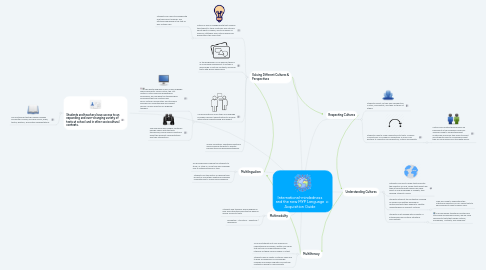
1. Students and teachers have access to an expanding and ever-changing variety of texts at school and in other sociocultural contexts.
1.1. The multimodal texts go beyond spoken and written modes, including visual, audio, tactile, gestural, and spatial representations.
2. Valuing Different Cultures & Perspectives
2.1. Criteria A and B: Engaging with text requires the student to think creatively and critically about what is viewed, and to be aware of opinions, attitudes and cultural references presented in the visual text.
2.1.1. Students also need to engage with and think about feelings and attitudes expressed in the text as well as their own.
2.2. In the progression of of learning, there is an increasing requirement to include a wide range of cultural contexts, including texts with global significance
2.3. Communicating in more than one language provides excellent opportunities to develop intercultural understanding and respect
2.3.1. The digital language is also a new language which represents a new culture, the 21st century culture. Beyond geographical boundaries, we now have the technological boundaries that are creating new socio-cultural communities. And the same principles of understanding and respect remain a major objective of language teachers.
2.3.2. The new guide encourages creating a dialogic space with the texts themselves, posing inquiry questions about the different representations and their interactions.
2.4. Inquiry Questions: Debatable questions should require students to evalute perspectives and developing theories
3. Multilingualism
3.1. All IB programmes require the students to study, or study in, more than one language over a sustained period of time.
3.2. Students can take action or develop their project by using their additional language competencies to reach more audiences
4. Multiliteracy
4.1. To be multiliterate not only requires an understanding of spoken, written and visual text but also an understanding of the interplay of these various modes in a text.
4.2. Students need a variety of literacy skills and to have an awareness of increasingly complex and diverse linguistic and cultural contexts in which to communicate.
5. Multimodality
5.1. Students and teachers should engage in new and interesting ways that go beyond simple access to texts.
5.2. Perceptual - Structural - Analytical / Ideological
6. Respecting Cultures
6.1. Students reflect on their own perspective, culture, and identity, and then on those of others.
6.2. Students need to make connections to texts. “Analyse connections” is included in Objectives A and B. This pertains to reflection on perspective, culture and identity.
6.2.1. Critical and creative thinking skills are paramount in the language classroom. Teachers need to understand what multimodal resources they need to select and students need to comprehend what they are consuming from the digital world.
7. Understanding Cultures
7.1. Authentic and multi-modal texts promote the selection of local, global texts about real topics/issues/problems which will likely result in new knowledge or insights, thus opening students' minds.
7.2. Students interpret the contextual meaning of spoken and written language in multimodal texts thus leading to a better understanding of different cultures.
7.2.1. They also need to understand the intentional selection of non-verbal texts to add meaning to what is being "said".
7.3. Students must engage with a variety of interpersonal and cultural situations and contexts
7.3.1. In an age where traditional frontiers are becoming increasingly blurred, we are more exposed to texts that merge cultures, knowledge, contexts, and audiences.
